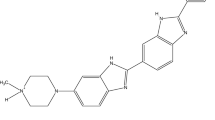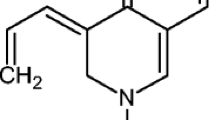Abstract
Looking to the recent roles of topoisomerases in various types of cancers, in the present paper, a quantitative structure–activity relationship model, based on genetic function approximation (GFA) method, was developed using 41 olivacine derivatives as inhibitors of topoisomerase IIβ (Topo IIβ). The best predictive GFA model explained the biological activity of the training and test sets with correlation coefficient values (r 2) of 0.747 and 0.549, respectively, and a significant cross-validated correlation coefficient (q 2) of 0.525. The model suggested positive correlation between activity and descriptors, namely partition coefficient (ALogP), electrostatic energy, number of hydrogen bond acceptors and number of rotatable bonds, while those of negative correlations with Jurs RPCG, Jurs TASA and PHI. Furthermore, a common feature-based pharmacophore model for these inhibitors was also developed which comprised of five features, namely one H-bond acceptor, two ring aromatic, one positive ionizable and one hydrophobic group. Screening of a large database for natural compounds, using both these developed models, led to identification of the pyrrole derivative, namely 1-(2-(dimethylamino)ethyl)-3-hydroxy-4-(4-methoxy-2-methylbenzoyl)-5-(3,4,5-trimethoxyphenyl)-1H-pyrrol-2(5H)-one (compound ID: STOCK1N-31995) with a predicted IC50 value of 0.3 × 10−6 µM as most potent inhibitor of Topo IIβ. The result of virtual screening was further validated using molecular dynamics (MD) simulation analysis. Thus, a 15 ns MD simulation analysis revealed high stability and effective binding of 1-(2-(dimethylamino)ethyl)-3-hydroxy-4-(4-methoxy-2-methylbenzoyl)-5-(3,4,5-trimethoxyphenyl)-1H-pyrrol-2(5H)-one within the active site of Topo IIβ.









Similar content being viewed by others
References
Ahirwar S, Shrivastava A, Pathak AK (2014) 2D QSAR study of novel quinoline derivatives as potent antitubercular agents. J Comput Meth Mol Des 4:6–13
Asgaonkar KD, Mote GD, Chitre TS (2014) QSAR and Molecular docking studies of oxadiazole-ligated pyrrole derivatives as Enoyl-ACP (CoA) reductase inhibitors. Sci Pharm 82:71–85
Auradee P, Pungpo P, Kamsri P, Kasamsri D, Srisupan A, Saparpakorn P, Hannongbua S, Wolschann P, Prueksaaroon S, Pongprom N (2013) Molecular dynamics simulations of azanaphthoquinone annelated pyrrole derivatives as anticancer agent in DNA duplex. Comput Biochem Biophy 4:555–562
Austin CA, Sng JH, Patel S, Fisher LM (1993) Novel HeLa Topo II is the II beta isoform: complete coding sequence and homology with other type II topoisomerases. Biochem Biophys Acta 1172:283–291
Awasthi M, Singh S, Pandey VP, Dwivedi UN (2015) Molecular docking and 3D-QSAR based virtual screening of flavonoids as potential aromatase inhibitors against estrogen-dependent breast cancer. J Biomol Struct Dyn 33:804–819
Braybrooke J, Ranson M, Manegold C (2003) Phase II study of mesylate (DX-8951F) as first line therapy for advanced non-small cell lung cancer. Lung Cancer 41:215–219
Burden DA, Osheroff N (1998) Mechanism of action of eukaryotic Topo II and drugs targeted to the enzyme. Biochem Biophys Acta 1400:139–154
Champoux JJ (2001) DNA topoisomerases: structure, function, and mechanism. Annu Rev Biochem 70:369–413
ChandraSekhar KVG, Vyas DRK, Nagesh HN, Rao VS (2012) Pharmacophore hypotheses for atypical antipsychotics. Bull Korean Chem Soc 33:2930–2936
Chhatriwala H, Jafri N, Salgia R (2006) A review of Topo I inhibition in lung cancer. Cancer Biol Ther 5:1600–1607
Dayam R, Laith Q, Al-Mawsawi ZZ, Myriam W, Zeger D, Nouri N (2008) Quinolone 3-carboxylic acid pharmacophore: design of second generation HIV-1 integrase inhibitors. J Med Chem 51:1136–1144
Forte B, Malgesini B, Piutti C, Quartieri F, Scolaro A, Papeo G (2009) A submarine journey: the pyrrole-imidazole alkaloids. Mar Drugs 7:705–753
Frimayanti N, Yam ML, Lee HB, Othman R, Zain SM, Rahman NA (2011) Validation of quantitative structure-activity relationship (QSAR) model for photosensitizer activity prediction. Int J Mol Sci 12:8626–8644
Golbraikh A, Tropsha A (2002) Beware of q2. J Mol Graph Model 20:269–276
Guillonneau C, Pierre A, Charton Y, Guilbaud N, Kraus-Berthier L, Le once S, Michel A, Bisagni E, Atassi G (1999) Synthesis of 9-O-substituted derivatives of 9-hydroxy-5, 6-dimethyl-6hpyrido [4, 3-b] carbazole-1-carboxylic acid (2-(Dimethylamino) ethyl) amide and their 10- and 11-methyl analogues with improved antitumor activity. J Med Chem 42:2191–2203
Hansch C, Leo A (1995) In exploring QSAR: fundamentals and applications in chemistry and biology. American Chemical Society, Washington D.C
Idhayadhulla A, Kumar SR, Nasser AJA, Manilal A (2011) Synthesis of some new pyrrole derivatives and their antimicrobial activity. Der Pharma Chemica 4:210–218
Idhayadhulla A, Kumar SR, Nasser AJA, Manilal A (2013) Synthesis of some new pyrrole and pyridine derivatives and their antimicrobial, anticancer activities. Int J Biol Chem 7:15–26
Jarvinen TA, Liu ET (2003) HER-2/neu and Topo II alpha in breast cancer. Breast Cancer Res Treat 78:299–311
Jenkins JR, Ayton P, Jones T, Davies SL, Simmons DL, Harris AL, Sheer D, Hickson ID (1992) Isolation of cDNA clones encoding the beta isozyme of human DNA Topo II and localization of the gene to chromosome 3p24. Nucleic Acids Res 20:5587–5592
Kellner U, Sehestedb M, Jensenb PB, Gieselerc F, Rudolphd P (2002) Culprit and victim-DNA topoisomerase II. Lancet Oncol 3:235–243
Khaled KF, Abdel-Shafi NS (2011) Quantitative structure and activity relationship modeling study of corrosion inhibitors: genetic function approximation and molecular dynamics simulation methods. Int J Electrochem Sci 6:4077–4094
Konkimalla VB, Efferth T (2010) Inhibition of epidermal growth factor receptor over-expressing cancer cells by the aphorphine-type isoquinoline alkaloid, dicentrine. Biochem Pharmacol 79:1092–1099
La RG, Bai R, Coluccia A, Famiglini V, Pelliccia S, Passacantilli S, Mazzoccoli C, Ruggieri V, Sisinni L, Bolognesi A, Rensen WM, Miele A, Nalli M, Alfonsi R, Di Marcotullio L, Gulino A, Brancale A, Novellino E, Dondio G, Vultaggio S, Varasi M, Mercurio C, Hamel E, Lavia P, Silvestri R (2014) New pyrrole derivatives with potent tubulin polymerization inhibiting activity as anticancer agents including hedgehog-dependent cancer. J Med Chem 15:6531–6552
Le Mee S, Pierre A, Markovits J, Atassi G, Jacquemin-Sablon A, Saucier JM (1998) S16020-2, a new highly cytotoxic antitumor olivacine derivative: DNA interaction and DNA topoisomerase II inhibition. Mol Pharmacol 53:213–220
Leon P, Garbay-Jaureguiberry C, Barsi MC, Le Pecq JB, Roques BP (1987) Modulation of the antitumor activity by methyl substitutions in the series of 7H-pyridocarbazole monomers and dimers. J Med Chem 30:2074–2080
Liu LF (1994) DNA topoisomerases: biochemistry and molecular biology. Academic Press, New York
Liu Y, Gao F, Jiang H, Niu L, Bi Y, Young CY, Yuan H, Lou H (2013) Induction of DNA damage and ATF3 by retigeric acid B, a novel Topo II inhibitor, promotes apoptosis in prostate cancer cells. Cancer Lett 337:66–76
Martin MT, Harten P, Young DM, Muratov EN, Golbraikh A, Zhu H, Tropsha A (2012) Does rational selection of training and test sets improve the outcome of QSAR modeling? J Chem Inf Model 52:2570–2578
More VD, Choudhari PB, Dhavale RP, Jadhav SD, Bhatia MS (2012) 3D QSAR study on alpha keto amide derivatives as gp120-CD4 inhibitors. Int J Pharm Sci Drug Res 4:19–24
Mosher CW, Crews OP, Action EM, Goodman LJ (1966) Preparation and antitumor activity of olivacine and some new analogs. Med Chem 9:237–241
Munster PN, Daud AI (2011) Preclinical and clinical activity of the Topo I inhibitor, karenitecin, in melanoma. Expert Opin Investig Drugs 20:1565–1574
Ohashi M, Oki T (1996) Ellipticine and related anticancer agents. Expert Opin Ther Pat 6:1285–1294
Ohashi M, Sugikawa E, Nakanishi N (1995) Inhibition of P53 protein phosphorylation by 9-hydroxyellipticine: a possible anticancer mechanism. Jpn J Cancer Res 86:819–827
Patel A, Shah S, Panchal I (2014) Chemo resistance: a major hurdle of cancer therapeutics. Int J Pharma Bio Sci 3:256–267
Pelaprat D, Delbarre A, Leguen I, Roques BP (1980) DNA intercalating compounds as potential antitumor agents. 2. Preparation and properties of 7H-pyridocarbazole dimers. J Med Chem 23:1336–1343
Prescott TA, Sadler IH, Kiapranis R, Maciver SK (2007) Lunacridine from Lunasia amara is a DNA intercalating topoisomerase II inhibitor. J Ethnopharmacol 109:289–294
Rogers D, Hopfinger AJJ (1994) Application of genetic function approximation to quantitative structure-activity relationships and quantitative structure-property relationships. Chem Inf Comput Sci 34:854–866
Sakkiah S, Thangapandian S, John S, Lee KW (2011) Pharmacophore based virtual screening, molecular docking studies to design potent heat shock protein 90 inhibitors. Eur J Med Chem 46:2937–2947
Schiller JH, Harrington D, Belani CP, Langer C, Sandler A, Krook J, Zhu J, Johnson DH (2002) Comparison of four chemotherapy regimens for advanced non small cell lung cancer. N Engl J Med 346:92–98
Schmutz J, Hunzicker F (1958) Alkaloids of aspidosperma olivaceum. Acta Helv 30:341–347
Schuttelkopf AW, van Aalten DM (2004) PRODRG: a tool for high-throughput crystallography of protein-ligand complexes. Acta Crystallogr D Biol Crystallogr 60:1355–1363
Singh M, Singh SK, Chhabria MT (2012) A novel QSAR model for evaluating and predicting the inhibition activity of H1-receptor antagonists: a series of thienopyrimidine derivatives. J Drug Deliv Ther 2:6–15
Tewey KM, Chen GL, Nelson EM, Liu LF (1984) Interactive antitumor drug interferes with the breakage-reunion reaction of mammalian DNA topoisomerase II. J Biol Chem 259:9182–9187
Thakur DS (2011) Topoisomerase II inhibitors in cancer treatment. Int J Pharm Sci Nanotechnol 3:1173–1181
Tylinska B, Jasztold-Howorko R, Mastalarz H, Klopotowska D, Filip B, Wietrzyk J (2010) Synthesis and structure-activity relationship analysis of new olivacine derivatives. Acta Poloniae Pharm-Drug Res 67:495–502
Vassetzky YS, Alghisi GC, Gasser SM (1995) DNA topoisomerase II mutations and resistance to anti-tumor drugs. Bioessays 17:767–774
Veerasamy R, Rajak H, Jain A, Sivadasan S, Varghese CP, Agrawal RK (2011) Validation of QSAR models- strategies and importance. Int J Drug Des Discov 2:511–519
Wang JC (2002) Cellular roles of DNA topoisomerases: a molecular perspective. Nat Rev Mol Cell Biol 6:430–440
Yang SY (2010) Pharmacophore modeling and applications in drug discovery: challenges and recent advances. Drug Discov Today 15:440–450
Zhang SX, Feng J, Kuo SC, Brossi A, Hamel E, Tropsha A, Lee KH (2000) Three-dimensional quantitative structure-activity relationship study of the colchicine binding site ligands using comparative molecular field analysis. J Med Chem 43:167–176
Acknowledgments
Financial support from Department of Science and Technology (DST), Government of India, New Delhi in the form of DST-INSPIRE-SRF to SS is gratefully acknowledged. Financial supports from Department of Biotechnology, Government of India, New Delhi under BIF, DST under PURSE programme and Department of Higher Education, Government of Uttar Pradesh under Center of Excellence programme for infrastructural facilities are also gratefully acknowledged.
Conflict of interest
There is no conflict of interest.
Author information
Authors and Affiliations
Corresponding author
Electronic supplementary material
Below is the link to the electronic supplementary material.
Rights and permissions
About this article
Cite this article
Singh, S., Awasthi, M., Pandey, V.P. et al. Molecular dynamics simulated validation of anti-cancerous alkaloids as Topo IIβ inhibitors screened by QSAR, pharmacophore and molecular docking approaches. Med Chem Res 24, 2972–2985 (2015). https://doi.org/10.1007/s00044-015-1351-7
Received:
Accepted:
Published:
Issue Date:
DOI: https://doi.org/10.1007/s00044-015-1351-7




